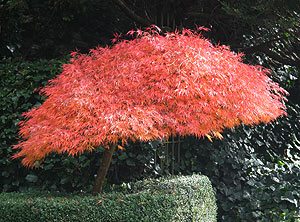Dwarf Japanese Maples are a truly versatile plant for any garden. They grow well planted directly in the garden and are also well suited to growing in containers, offering a range of varieties and foliage colours. Size typically ranges from 1 to 2 meters, depending on the variety and grafting method, and are typically slow growers.
These low-growing trees have wonderful foliage from spring through late summer. When the cooler weather settles in during autumn, the foliage undergoes a fantastic colour change that adds more impact.

Throughout spring and summer, all varieties display attractive foliage, spanning from greens to rich reds and purples. The leaf type also varies among the different varieties.
While many Dwarf Japanese Maples have a weeping or cascading form, others grow upright or even take on a ball-shaped appearance. They suit a wide range of garden styles and grow well in container gardening as well.
Varieties
- Acer palmatum dissectum ‘Crimson Queen’
An excellent form with finely dissected foliage. As the name suggests, the foliage is a nice crimson through spring and summer, turning to more reddish tones in autumn as the cool weather settles in. - Acer palmatum ‘Baby Lace’
Red and green finely dissected foliage followed by red and orange in autumn. - Acer palmatum ‘Coonara Pygmy’
Green five-lobed foliage, deeply incised, with brilliant orange to red tones in autumn. This variety reaches around 2m in height. - Acer japonicum ‘Fairy Lights’
Very finely cut leaves. Slow growing but with brilliant scarlet red autumn foliage. - Acer palmatun ‘Skeeters Dwarf’
An unusual upright growth habit. Burgundy foliage. - Acer palmatum ‘Hanama Nishiki’
Very small foliage on an upright dwarf bush. - Acer cirinatum ‘Little Gem’
An unusual form of the vine maple. Green foliage in a tightly rounded bush to around 1m in height.
Pruning
Dwarf Japanese Maples typically require minimal pruning in the first few years, with usually the removal of dead or damaged branches. The tree’s natural form is often its most attractive feature. However, as they mature, a bit of pruning becomes beneficial.
In addition to clearing away dead wood, it is best to trim some of the branches that cross over or congest the tree’s canopy. This “opening up” of the tree allows sunlight in, reducing the risk of disease and deadwood. This will also give a structured appearance to the tree, ensuring its visual appeal throughout the seasons as well as in winter.
In some instances, they are trained to grow at a slant, which is particularly common in Japanese-style gardens, resulting in a windswept look.
It’s important to note that the actual height of these maples is not determined by pruning, but is set by the height of the graft, which can range from 1m, 2m or 3m.
How to Grow Dwarf Japanese Maples
- Full sun to part shade – protection from hot afternoon sun, but not deep shade.
- Humus-rich, moist but well-drained soil.
- Water in new plants with a liquid seaweed fertilizer.
- General purpose slow-release fertilizer in late winter to early spring as soon as new growth begins.
- If growing in containers, ensure adequate water in summer.
Resources
